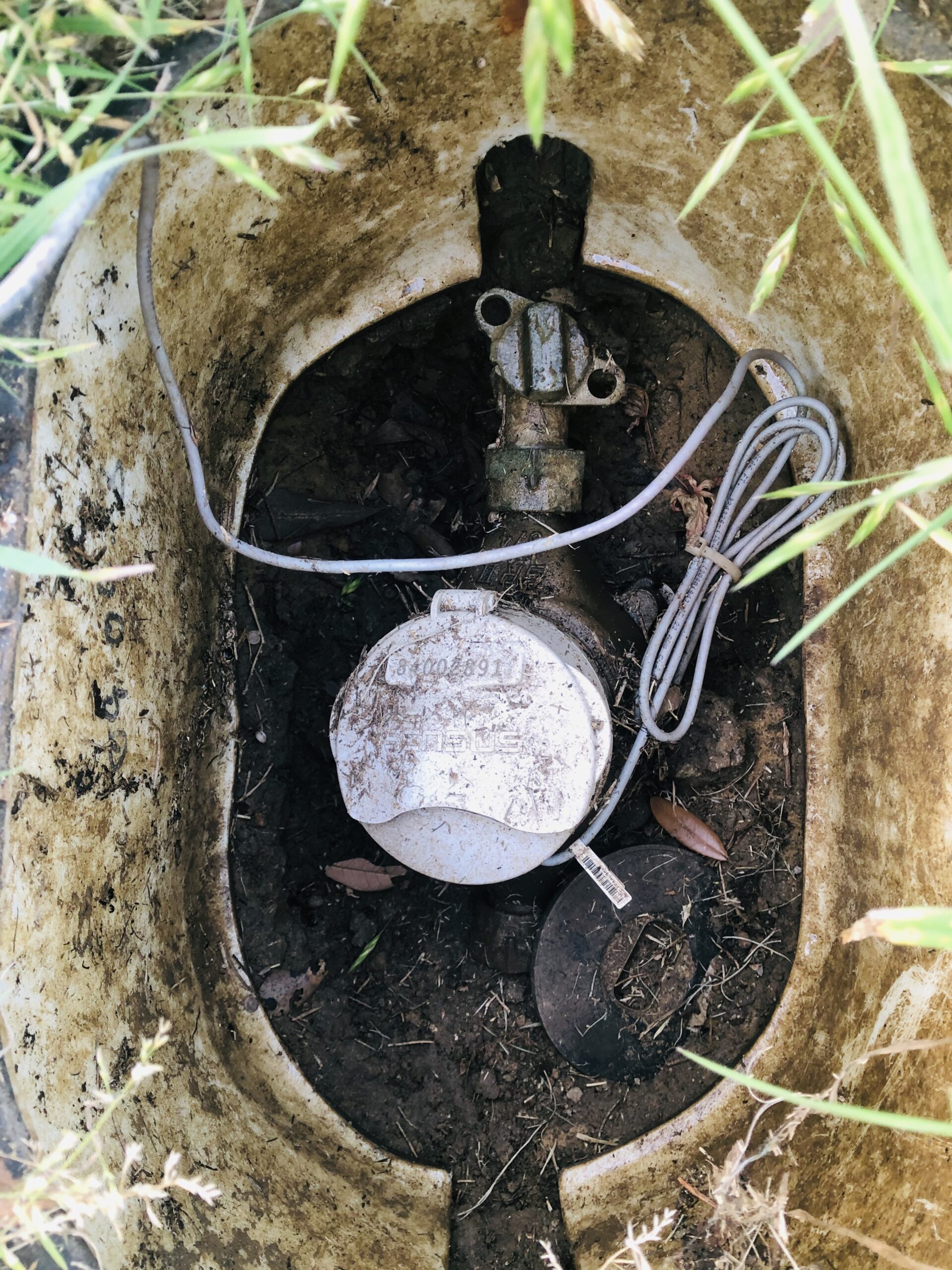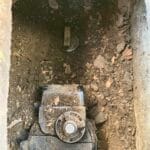Imagine you’re in the middle of a plumbing emergency, desperately trying to stop water from flooding your home, only to find your main water shut off valve stuck. It’s a scenario that can quickly turn from frustrating to overwhelming.
You might be wondering how you got here or what to do next. You’re not alone—many homeowners face this daunting issue. But don’t worry, there’s a solution. We’ll guide you through the steps to tackle this problem head-on, ensuring you can regain control and protect your home.
By the end, you’ll be equipped with the knowledge to handle a stuck valve like a pro, and you’ll never have to feel helpless in such a situation again. Ready to take back control? Let’s dive in.

Credit: augerpros.com
Identifying The Main Water Shut Off Valve
Understanding the main water shut off valve is crucial for homeowners. It controls the entire water supply to your home. In emergencies, a quick shut off can prevent water damage. Knowing its location and type helps in urgent situations.
Locating The Valve
Finding the main water shut off valve can seem tricky. It is often near the perimeter of the house. Look for it in the basement or a utility room. Sometimes, it’s outside near the water meter. In warmer climates, the valve may be underground. Check near the street, close to the property line. Each home is different, so inspect thoroughly.
Types Of Valves
Valves come in different types. The most common is the gate valve. It uses a wheel handle. Turn the wheel clockwise to stop water flow. Another type is the ball valve. It has a lever handle. Move the lever perpendicular to the pipe to shut off water. Both types are effective but operate differently. Knowing your valve type helps in emergencies.

Credit: www.youtube.com
Common Reasons For A Stuck Valve
Experiencing a stuck main water shut-off valve can be frustrating. Understanding the reasons can help prevent future problems. Some common issues include corrosion, sediment buildup, and age-related wear. Let’s explore these factors in detail.
Corrosion And Rust
Corrosion is a leading cause of stuck valves. Metal valves exposed to moisture can rust over time. This rust builds up, making it hard to turn the valve. Regular checks can prevent severe corrosion.
Sediment Buildup
Water carries tiny particles like minerals and dirt. These particles settle in the valve, causing sediment buildup. Over time, the buildup makes the valve hard to operate. Flushing the system regularly helps reduce sediment.
Age And Wear
Older valves can wear out and become less effective. Constant use over the years weakens the internal components. This wear and tear can lead to a stuck valve. Replacing older valves can prevent future issues.
Basic Tools Needed For Fixing
Fixing a stuck main water shut-off valve might seem daunting. With the right tools, it becomes manageable. This section outlines the basic tools needed. These tools make your repair process smooth and efficient.
Essential Tools
Have a wrench handy for loosening tight nuts. Adjustable wrenches work best. A penetrating oil is useful for stubborn valves. It helps lubricate and loosen rusted parts. A pair of pliers can grip and turn small components. They are invaluable in tight spaces. Don’t forget a screw driver. It is essential for detaching any covers or panels. Keep a bucket nearby. It catches any excess water during the repair.
Safety Gear
Protective gloves are vital. They safeguard your hands from sharp edges. Wear safety goggles to protect your eyes. Goggles prevent debris or rust from causing injury. Sturdy footwear is recommended. It ensures a firm grip on slippery surfaces. A flashlight is useful. It illuminates dark corners and hidden areas. Always have a towel. It dries your hands and tools quickly.
Diy Techniques To Free A Stuck Valve
Stuck main water shut-off valves can be a hassle. Simple DIY techniques can help loosen them safely. Applying penetrating oil and gently turning can often free up a stuck valve, ensuring smooth operation.
If you’ve ever faced a stuck main water shut-off valve, you know how frustrating it can be. Luckily, you don’t always need a professional to solve the problem. With a few DIY techniques, you can potentially free that stubborn valve yourself. Let’s explore some practical methods that you can try at home to get that valve turning again.Using Lubricants
Start with a good lubricant like WD-40 or a silicone-based spray. These products can seep into the valve’s threads and loosen any rust or corrosion. Simply spray the lubricant on the valve stem and let it sit for a few minutes. After allowing the lubricant to work its magic, try turning the valve gently. If it doesn’t budge, apply a bit more and wait a little longer. Sometimes patience is key, and repeating the process can yield results. Remember to wipe off any excess lubricant once the valve is free. This prevents attracting more dust or grime in the future. Have you tried this method before? It might surprise you how effective it can be.Applying Heat
Using a heat source like a hairdryer can expand the metal slightly. This expansion can help break the bond holding the valve in place. Focus the heat on the valve for a few minutes, ensuring you don’t overheat any plastic parts. Once heated, try turning the valve with a wrench or pliers. The added heat may just be the trick to get things moving again. However, be cautious and protect your hands with gloves to avoid burns. If you’re hesitant about using heat, remember it’s a common technique in plumbing. It might sound intimidating, but with care, it can be quite effective.Tapping With A Hammer
A gentle tap can sometimes jolt a stuck valve into action. Use a small hammer or a mallet and gently tap around the valve. This can help dislodge any debris or rust that’s causing the problem. Tapping should be done carefully to avoid damaging the valve or pipes. Start with light taps and gradually increase the force if necessary. It’s a simple yet surprisingly effective technique that many homeowners overlook. Have you ever tried this method on a stubborn valve? Sometimes, a little nudge is all it takes. Wouldn’t it be satisfying to hear that valve finally turn after a few taps? Remember, always exercise caution when performing these DIY techniques. If you’re not comfortable or if the valve remains stuck, seeking professional help is the best course of action. But with a bit of patience and effort, these methods might just save you a call to the plumber.Preventive Measures For Future Issues
Stuck main water shut-off valves cause big problems. Regularly check and lubricate valves to prevent sticking. This ensures easy access during emergencies.
When the main water shut-off valve gets stuck, it can lead to significant inconvenience and potential water damage. To avoid these frustrating scenarios, it’s essential to implement preventive measures. By focusing on regular maintenance, installing new valves, and scheduling professional inspections, you can ensure your plumbing system operates smoothly and efficiently. Let’s dive into practical steps that can save you from future headaches.Regular Maintenance
Regular maintenance is crucial to keep your main water shut-off valve in working condition. Make it a habit to operate the valve every few months. Turning it on and off ensures it doesn’t get stuck due to disuse. Think about it like stretching your muscles to keep them flexible. This simple action can prevent buildup and corrosion. You can also apply a bit of lubricant to the valve stem. This helps maintain smooth operation and reduces the chance of sticking.Installing New Valves
If your current valve is old or showing signs of wear, consider installing a new one. Modern valves often come with improved designs that resist corrosion and are easier to operate. Ball valves, for example, are a popular choice because they require only a quarter turn to shut off. They are less prone to sticking compared to traditional gate valves. Make sure the replacement valve is compatible with your plumbing system. If in doubt, consult a professional to ensure a seamless installation.Professional Inspection
Even with regular maintenance and new installations, professional inspections are invaluable. A plumber can detect potential issues that might not be visible to the untrained eye. Have you ever missed a small leak, only to find it had caused significant damage later? Professionals can catch these early signs and save you from costly repairs. Schedule an annual inspection to get expert advice and ensure everything is in top condition. This proactive approach can provide peace of mind and prolong the lifespan of your plumbing system. By taking these preventive measures, you not only safeguard your home but also enhance your understanding of its plumbing dynamics. What steps will you take today to prevent your valve from getting stuck in the future?
Credit: www.youtube.com
When To Call A Professional
Struggling with a main water shut off valve that won’t budge? It’s time to call a professional. Expert help ensures safety and prevents potential damage to your plumbing system.
When dealing with a stuck main water shut off valve, there comes a point when calling a professional is your best move. As much as you might like to tackle DIY tasks, certain situations require expert intervention. Knowing when to make that call can save you time, money, and a lot of frustration.Signs Of Severe Damage
If you notice water leaking around the valve, it could indicate a serious problem. A damaged valve can lead to water damage in your home. This is not just inconvenient; it can also be costly to repair. Another sign of severe damage is rust or corrosion on the valve. This can weaken the valve and eventually cause it to fail completely. Rust is often a sign that the valve has been compromised for some time. Hearing strange noises when you attempt to turn the valve is another red flag. Grinding or screeching sounds often mean internal damage. This is a clear indication that you should consult a professional immediately.Complex Plumbing Systems
If your home has a complex plumbing system, it’s wise to call a professional. Modern plumbing systems can be intricate and confusing. One wrong move might lead to a cascade of issues. I once thought I could fix a simple issue, only to discover a maze of pipes and fittings. It quickly became apparent that I was in over my head. That’s when I called a plumber, and it was the best decision I made. Do you know exactly how your plumbing system is laid out? If the answer is no, it’s safer to leave it to someone who does. Professionals have the tools and experience to navigate complex systems without causing further damage. Before deciding to tackle the issue on your own, consider the potential risks. Would you know how to fix a burst pipe if you accidentally caused one? Calling a professional might be the wisest choice for peace of mind.Frequently Asked Questions
Why Is My Main Water Valve Stuck?
It can get stuck due to rust, mineral deposits, or lack of use. Corrosion is common.
How Do I Unstick A Water Valve?
Use a wrench for gentle turns. Apply penetrating oil to loosen. Be patient and careful.
Can A Stuck Valve Cause Water Damage?
Yes, it can prevent water shut-off during leaks. Immediate attention is important to avoid damage.
Is It Safe To Fix A Stuck Valve Myself?
Yes, if you’re careful. But consult a plumber if unsure. Safety first.
How Often Should I Check My Water Valve?
Check it every six months. Regular checks prevent sticking and ensure easy operation.
Conclusion
Fixing a stuck main water shut off valve can be challenging. Follow the steps mentioned for effective results. Regular maintenance prevents future problems. Always handle tools carefully to avoid damage. Seek professional help if needed. Proper care ensures smooth valve operation.
Your home’s plumbing system will thank you. Remember, a functional valve is crucial. Protect your property from unexpected water issues. Stay informed and prepared. Your peace of mind depends on it. A little effort today can save you stress tomorrow.
Keep your plumbing system in top shape for worry-free living.



